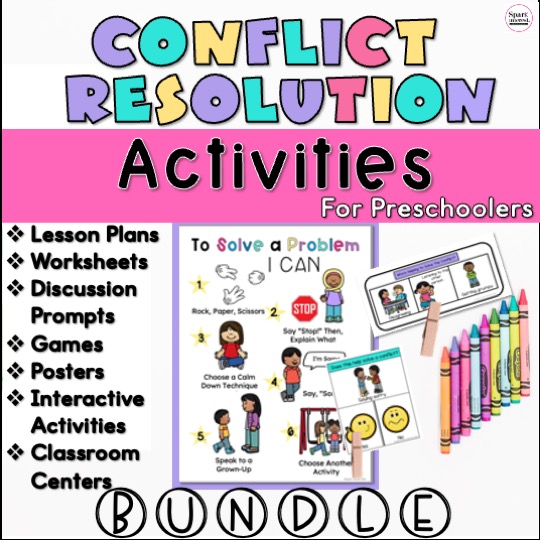
Conflict resolution is challenging for all of us. Imagine being a four year old in preschool and having to manage conflict with other children … as you can imagine, this can be downright hard. Our preschoolers are just beginning to understand and regulate their own emotions, to communicate their needs, to understand the size of a problem and all the while they are trying really hard to solve daily conflicts in the classroom with a bunch of 4 year olds, just like them!
They need our support. Our young learners need to develop their conflict resolution skills. This may sound like a daunting task, but don’t you fret… I’m here to help you figure out how to teach conflict resolution skills to your preschoolers so that you can have a calmer, more relaxed classroom.

What is Conflict Resolution?
Conflict resolution is a (formal or informal) process that two or more students go through to find a peaceful and effective way to solve their problem or dispute. Many cognitive and emotional issues that many students don’t even realize are happening can cause a conflict to become a bigger problem and cause the need for conflict resolution.
How to Teach Conflict Resolution
Trust me when I say, teaching conflict resolution to preschoolers is very doable. Our preschoolers are in our classrooms to develop their social emotional skills and conflict resolution is just one more of those SEL skills you need to incoporate into your lessons. If you are looking for some fun and effective ways to teach conflict resolution skills to preschoolers, here are some steps you can take to get started teaching conflict resolution.
Step 1: Size of the Problem
To preschoolers, problems can escalate into BIG problems very easily. Someone took their spot on the carpet, BIG problem. A student used the paintbrush they put down, BIG problem. A friend doesn’t want to play the same game as them, HUGE problem. You get the drift!
Before teaching conflict resolution to preschoolers, you want to review the size of the problem.
- What exactly is a big problem?
- What’s a medium size problem?
- What’s a small problem?
- What is the difference between them, and how do students know which problems require help from an adult or which problems they can deal with on their own?
Helping preschoolers understand the size of the problem and the type of responses for each is very helpful when you begin to teach conflict resolution.
Step 2: Teach Conflict Resolution Techniques
After you have discussed the size of the problem, you want to discuss the different techniques students can use when they are trying to solve a conflict. These techniques are self-explanatory for preschoolers and can easily be implemented in the classroom.
Some examples are:
- Speak to a grown up
- Walk away
- Choose another activity
- Rock paper scissors
- Say sorry
- Choose a calm down technique
- Say stop and explain why
You’ll want to practice these types of techniques with students using conflict resolution activities. It’s always best to incorporate them throughout your day, week, and year so that it’s easier for students to remember and become part of their daily routine. You can read more about different types of conflict resolution classroom activities here.

Step 3: Role Play Conflict Resolution Scenarios
Role-playing is one of the most effective strategies for teaching younger learners. Role-playing allows them to watch conflicts, test them out and discuss the different situations they see. It works best if you are first to role-play and then start to include students as you go through the different scenarios. Choose different types of preschool conflict resolution scenarios that have happened in your classroom and with your students to make the process even more effective. Children love seeing themselves in the scenarios you recreate, use them as inspiration when coming up with scenarios to act out and discuss.

Step 4: Play Games to Teach Conflict Resolution
Consider creating a bingo board, playing matching games, or having classroom centers to reinforce conflict resolution techniques. You can easily create your own bingo boards by placing different conflict resolution techniques in each square. These games are a gateway to discussions and can be played with one child or between groups of children.
Preschoolers love games, and it gives them a fun way to practice the techniques and conflict resolution strategies you are trying to teach them. They probably won’t even realize they are playing a conflict-resolution-themed game.

Step 5: Involve Families
It’s always important to include families when you are teaching important skills and techniques. Make sure you inform parents what you are doing so they can reinforce it at home. Send home a conflict resolution techniques booklet that your students can illustrate. If you are looking for something quick and easy, grab a FREE resolution techniques booklet here!
Using these steps will make the teaching of conflict resolution much easier in your classroom and allow your students to gain valuable skills they will use for the rest of their life.

Teach Conflict Resolution Skills

Conflict resolution is something all preschoolers should learn during their time in your classroom. It will make them more effective learners, and allow them to have healthy relationships with their peers and other adults. And the best thing of all is once your students have the skills needed to resolve their own conflicts, you will have less students coming up to you throughout the day asking you to help solve minor conflicts! For us preschool teachers, that is gold!
Looking to learn more? Check out these blog posts:
Let's Connect:

Sara
